Other Galaxies
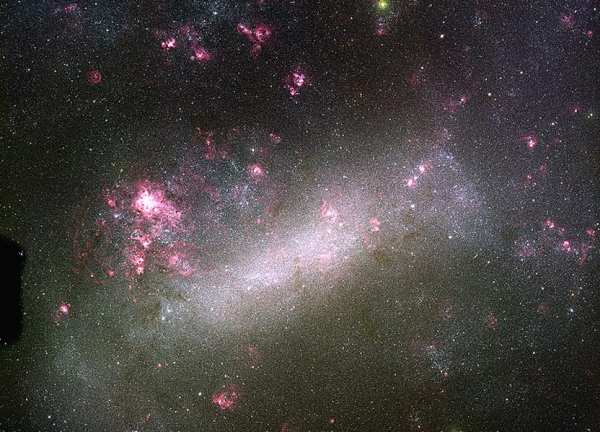
The LMC
Large Megellanic Cloud
This relatively small neighbor of ours is an irregular dwarf galaxy, and along with its cousin, the Small Magellanic Cloud (SMC), is visible to the naked eye in the Southern hemisphere. They are only about 180,000 and 200,000 light-years away, respectively, whereas the nearest major galaxy, Andromeda (M31), is over 2 million light-years away.
They are named for the explorer Magellan who brought them to the attention of the European world in 1519. In the early 1980's still another was discovered, dubbed the Mini Magellanic Cloud (MMC), hiding behind the SMC, 20,000 light-years beyond, and appears to have been a part of the SMC until it was torn loose by a near collision with the LMC some 200 million years ago.
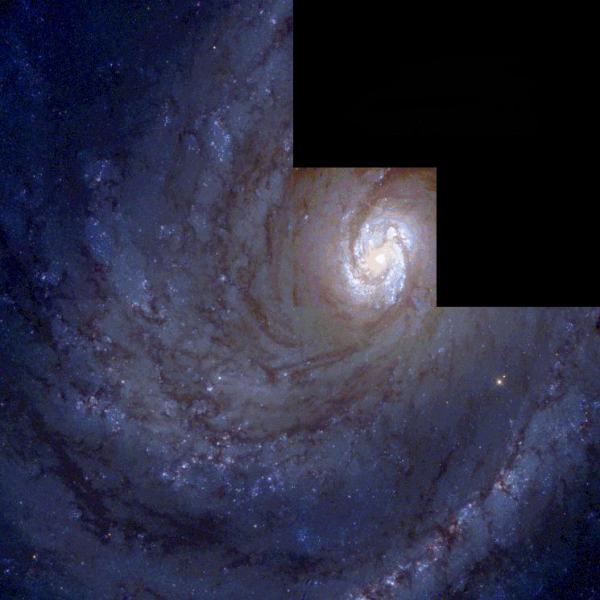
The Spiral Galaxy M100
Ground-based photo by the 3.9m Anglo-Australian Telescope, 1992
An image of the grand design of spiral galaxy M100 obtained with NASA's Hubble Space Telescope resolves individual stars within the majestic spiral arms. These stars typically appeared blurred together when viewed with ground-based telescopes. HST's image is chevron-shaped because it is a mosaic of the instrument's three wide-field cameras and one planetary camera.
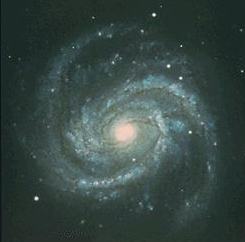
Hubble has the ability to resolve individual stars in other galaxies and measure accurately the light from very faint stars. This makes the space telescope invaluable for identifying a rare class of pulsating stars, called Cepheid Variable stars embedded within M100's spiral arms.
Cepheids are reliable cosmic distance mileposts. The interval it takes for the Cepheid to complete one pulsation is a direct indication of the star's intrinsic brightness. This value can be used to make a precise measurement of the galaxy's distance, which turns out to be 56 million light-years.
M100 (100th object in the Messier catalog of non-stellar objects) is a majestic face-on spiral galaxy. It is a rotating system of gas and stars, similar to our own galaxy, the Milky Way. Hubble routinely can view M100 with a level of clarity and sensitivity previously possible only for the very few nearby galaxies that compose our "Local Group.''
M100 is a member of the huge Virgo cluster of an estimated 2,500 galaxies. The galaxy can be seen by amateur astronomers as a faint, pinwheel-shaped object in the spring constellation Coma Berenices.
The Hubble Space Telescope image was taken on December 31, 1993 with the Wide Field Planetary Camera 2 (WFPC 2). This color picture is a composite of several images taken in different colors of light. Blue corresponds to regions containing hot newborn stars.

Magnificent Details in a Dusty Spiral Galaxy
In 1995, the majestic spiral galaxy NGC 4414 was imaged by the Hubble Space Telescope as part of the HST Key Project on the Extragalactic Distance Scale. An international team of astronomers, led by Dr. Wendy Freedman of the Observatories of the Carnegie Institution of Washington, observed this galaxy on 13 different occasions over the course of two months.
Images were obtained with Hubble's Wide Field Planetary Camera 2 (WFPC2) through three different color filters. Based on their discovery and careful brightness measurements of variable stars in NGC 4414, the Key Project astronomers were able to make an accurate determination of the distance to the galaxy.
The resulting distance to NGC 4414, 19.1 megaparsecs or about 60 million light-years, along with similarly determined distances to other nearby galaxies, contributes to astronomers' overall knowledge of the rate of expansion of the universe. The Hubble constant (H0) is the ratio of how fast galaxies are moving away from us to their distance from us. This astronomical value is used to determine distances, sizes, and the intrinsic luminosities for many objects in our universe, and the age of the universe itself.
Due to the large size of the galaxy compared to the WFPC2 detectors, only half of the galaxy observed was visible in the datasets collected by the Key Project astronomers in 1995. In 1999, the Hubble Heritage Team revisited NGC 4414 and completed its portrait by observing the other half with the same filters as were used in 1995. The end result is a stunning full-color look at the entire dusty spiral galaxy. The new Hubble picture shows that the central regions of this galaxy, as is typical of most spirals, contain primarily older, yellow and red stars. The outer spiral arms are considerably bluer due to ongoing formation of young, blue stars, the brightest of which can be seen individually at the high resolution provided by the Hubble camera. The arms are also very rich in clouds of interstellar dust, seen as dark patches and streaks silhouetted against the starlight.
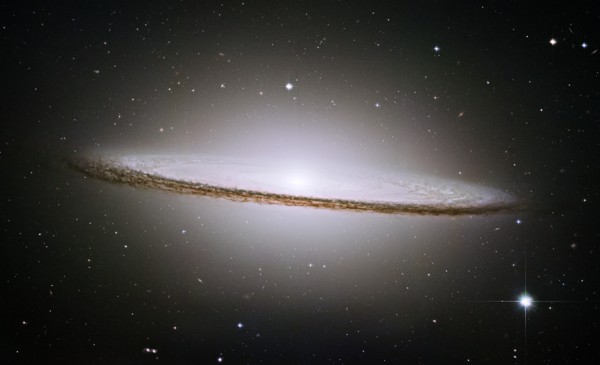
M104, The Sombrero Galaxy
NASA's Hubble Space Telescope has trained its razor-sharp eye on one of the universe's most stately and photogenic galaxies, the Sombrero galaxy, Messier 104 (M104). The galaxy's hallmark is a brilliant white, bulbous core encircled by the thick dust lanes comprising the spiral structure of the galaxy. As seen from Earth, the galaxy is tilted nearly edge-on. We view it from just six degrees south of its equatorial plane. This brilliant galaxy was named the Sombrero because of its resemblance to the broad rim and high-topped Mexican hat.
At a relatively bright magnitude of +8, M104 is just beyond the limit of naked-eye visibility and is easily seen through small telescopes. The Sombrero lies at the southern edge of the rich Virgo cluster of galaxies and is one of the most massive objects in that group, equivalent to 800 billion suns. The galaxy is 50,000 light-years across and is located 28 million light-years from Earth.
Hubble easily resolves M104's rich system of globular clusters, estimated to be nearly 2,000 in number — 10 times as many as orbit our Milky Way galaxy. The ages of the clusters are similar to the clusters in the Milky Way, ranging from 10-15 billion years old. Embedded in the bright core of M104 is a smaller disk, which is tilted relative to the large disk. X-ray emission suggests that there is material falling into the compact core, where a 1-billion-solar-mass black hole resides.
In the 19th century, some astronomers speculated that M104 was simply an edge-on disk of luminous gas surrounding a young star, which is prototypical of the genesis of our solar system. But in 1912, astronomer V. M. Slipher discovered that the hat-like object appeared to be rushing away from us at 700 miles per second. This enormous velocity offered some of the earliest clues that the Sombrero was really another galaxy, and that the universe was expanding in all directions.
The Hubble Heritage Team took these observations in May-June 2003 with the space telescope's Advanced Camera for Surveys. Images were taken in three filters (red, green, and blue) to yield a natural-color image. The team took six pictures of the galaxy and then stitched them together to create the final composite image. One of the largest Hubble mosaics ever assembled, this magnificent galaxy is nearly one-fifth the diameter of the full moon.
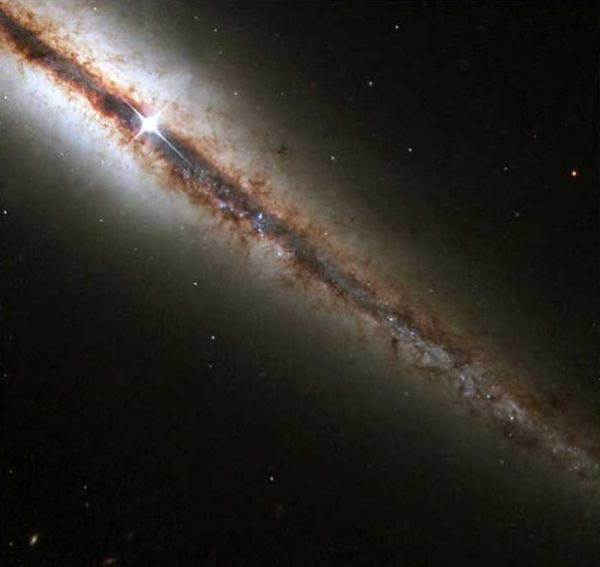
NGC 4013: A Galaxy on the Edge
Acknowledgment: J.C. Howk (Johns Hopkins University) and B.D. Savage (University of Wisconsin-Madison)
NGC 4013 is a spiral galaxy similar to our own Milky Way, lying some 55 million light-years from Earth in the direction of the constellation Ursa Major. Viewed pole-on, it would look like a nearly circular pinwheel, but NGC 4013 happens to be seen edge-on from our vantage point. Even at 55 million light-years, the galaxy is larger than Hubble's field of view, and the image shows only a little more than half of the object, albeit with unprecedented detail.
Dark clouds of interstellar dust stand out in the picture because they absorb the light of background stars. Most of the clouds lie in the plane of the galaxy, forming the dark band, about 500 light-years thick, that appears to cut the galaxy in two from upper right to lower left. A similar effect can be seen in our own sky. If one views the Milky Way by going well away from city lights, dust clouds in the disk of our own galaxy appear to split the glowing band of the Milky Way in two.
When light passes through a volume containing small particles (for example, molecules in the Earth's atmosphere, or interstellar dust particles in galaxies), it becomes fainter and redder. By studying the color and the amount of light absorbed by these distant clouds in NGC 4013, astronomers can estimate the amount of matter in them. Individual clouds contain as much as one million times the amount of mass in our Sun.
Dark interstellar clouds are believed to be where new stars are formed. Later, when the dust disperses, the young stars become visible as clusters of blue stars. NGC 4013 shows several examples of these stellar kindergartens near the center of the image, lying in front of the dark band along the galaxy's equator. The extremely bright star near the upper left corner, however, is merely a nearby foreground star belonging to our own Milky Way, which happens to lie in the line of sight to NGC 4013.
This Hubble Heritage picture was constructed from Hubble images taken in January 2000 by Dr. J. Christopher Howk (Johns Hopkins University) and Dr. Blair D. Savage (University of Wisconsin-Madison). Images taken through three different filters have been combined into a color composite, covering the region of the nucleus of the galaxy (behind the bright foreground star at the upper left), and extending along one edge of the galaxy to the lower right.

Galactic Silhouettes
This image by the Hubble Space Telescope and its Wide Field Planetary Camera 2 (WFPC2) shows the unique galaxy pair called NGC 3314. Through an extraordinary chance alignment, a face-on spiral galaxy lies precisely in front of another larger spiral. This line-up provides us with the rare chance to visualize dark material within the front galaxy, seen only because it is silhouetted against the object behind it.
Dust lying in the spiral arms of the foreground galaxy stands out where it absorbs light from the more distant galaxy. This silhouetting shows us where the interstellar dust clouds are located, and how much light they absorb. The outer spiral arms of the front galaxy appear to change from bright to dark, as they are projected first against deep space, and then against the bright background of the other galaxy.
NGC 3314 lies about 140 million light-years from Earth, in the direction of the southern hemisphere constellation Hydra. The bright blue stars forming a pinwheel shape near the center of the front galaxy have formed recently from interstellar gas and dust.
In many galaxies, interstellar dust lies only in the same regions as recently formed blue stars. However, in the foreground galaxy, NGC 3314a, there are numerous additional dark dust lanes that are not associated with any bright young stars.
A small, red patch near the center of the image is the bright nucleus of the background galaxy, NGC 3314b. It is reddened for the same reason the setting sun looks red. When light passes through a volume containing small particles (molecules in the Earth's atmosphere or interstellar dust particles in galaxies), its color becomes redder.
The Hubble Heritage color image of NGC 3314 was constructed from archival images taken with WFPC2 in April 1999 by Drs. William Keel and Ray White III (University of Alabama) in blue and infrared light, combined with new images obtained by the Heritage team in March 2000 using blue, green and red filters.
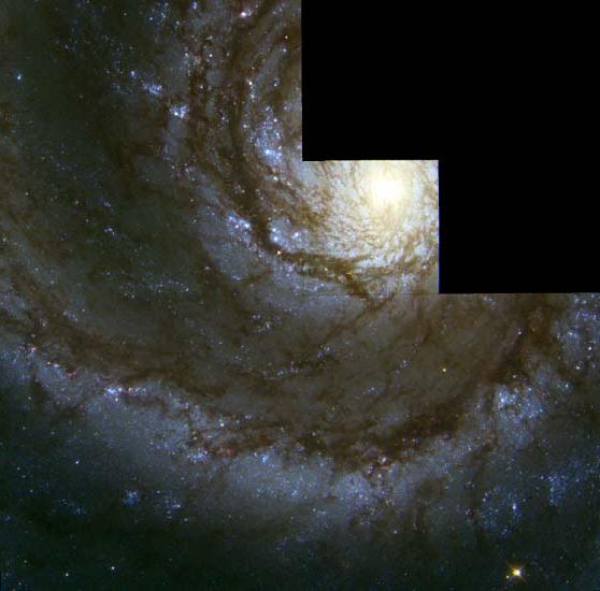
The Heart of the Whirlpool Galaxy
Acknowledgment: N. Scoville (Caltech) and T. Rector (NOAO)
The Whirlpool galaxy, M51, has been one of the most photogenic galaxies in amateur and professional astronomy. Easily photographed and viewed by smaller telescopes, this celestial beauty is studied extensively in a range of wavelengths by large ground- and space-based observatories. This Hubble composite image shows visible starlight as well as light from the emission of glowing hydrogen, which is associated with the most luminous young stars in the spiral arms.
M51, also known as NGC 5194, is having a close encounter with a nearby companion galaxy, NGC 5195, just off the upper edge of this image. The companion's gravitational pull is triggering star formation in the main galaxy, as seen in brilliant detail by numerous, luminous clusters of young and energetic stars. The bright clusters are highlighted in red by their associated emission from glowing hydrogen gas.
This Wide Field Planetary Camera 2 image enables a research group, led by Nick Scoville (Caltech), to clearly define the structure of both the cold dust clouds and the hot hydrogen and link individual clusters to their parent dust clouds. Team members include M. Polletta (U. Geneva); S. Ewald and S. Stolovy (Caltech); R. Thompson and M. Rieke (U. of Arizona).
Intricate structure is also seen for the first time in the dust clouds. Along the spiral arms, dust "spurs" are seen branching out almost perpendicular to the main spiral arms. The regularity and large number of these features suggests to astronomers that previous models of "two-arm" spiral galaxies may need to be revisited. The new images also reveal a dust disk in the nucleus, which may provide fuel for a nuclear black hole.
The team is also studying this galaxy at near-infrared wavelengths with the NICMOS instrument onboard Hubble. At these wavelengths, the dusty clouds are more transparent and the true distribution of stars is more easily seen. In addition, regions of star formation that are obscured in the optical images are newly revealed in the near-infrared images.
This image was composed by the Hubble Heritage Team from Hubble archival data of M51 and is superimposed onto ground-based data taken by Travis Rector (NOAO) at the 0.9-meter telescope at the National Science Foundation's Kitt Peak National Observatory (NOAO/AURA) in Tucson, AZ.

The Central Region of Spiral Galaxy NGC 253
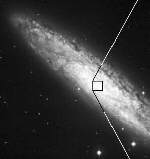
[Right] This NASA Hubble Space Telescope image of the core of the nearest starburst spiral galaxy, NGC 253, reveals violent star formation within a region 1,000 light-years across. A starburst galaxy has an exceptionally high rate of star birth, first identified by its excess of infrared radiation from warm dust. The galaxy is located about 8 million light-years away in the constellation Sculptor.
Hubble's high resolution allows astronomers to quantify complex structures in the starburst core of the galaxy for the first time, including luminous star clusters, dust lanes which trace regions of dense gas and filaments of glowing gas. Hubble identifies several regions of intense star formation, which include a bright, super-compact star cluster. These observations confirm that stars are often born in dense clusters within starbursts, and that dense gas coexists with and obscures the starburst core.
This image was taken with Hubble's Wide Field Planetary Camera 2 (in PC mode).

I Zwicky 18: A Baby Galaxy in a Grown-Up Universe
NASA's Hubble Space Telescope snapped a view of what may be the youngest galaxy ever seen. This "late bloomer" may not have begun active star formation until about 13 billion years after the Big Bang. Called I Zwicky 18 [below, left], the galaxy may be as young as 500 million years old. This youngster has gone though several sudden bursts of star formation — the first only some 500 million years ago and the latest only 4 million years ago. This galaxy is typical of the kinds of galaxies that inhabited the early universe. The galaxy is classified as a dwarf irregular galaxy and is much smaller than our Milky Way.
The two major starburst regions are the concentrated bluish-white knots embedded in the heart of the galaxy. The wispy blue filaments surrounding the central starburst region are bubbles of gas that have been heated by stellar winds and intense ultraviolet radiation unleashed by hot, young stars. The redder stars are slightly older stars and star clusters, but they are still less than 1 billion years old. A companion galaxy lies just above and to the right of the dwarf galaxy. The companion may be interacting with the dwarf galaxy and may have triggered that galaxy's recent star formation. The red blobs surrounding the dwarf galaxy are the dim glow from ancient fully formed galaxies.
This image was taken with Hubble's Advanced Camera for Surveys in 2003.
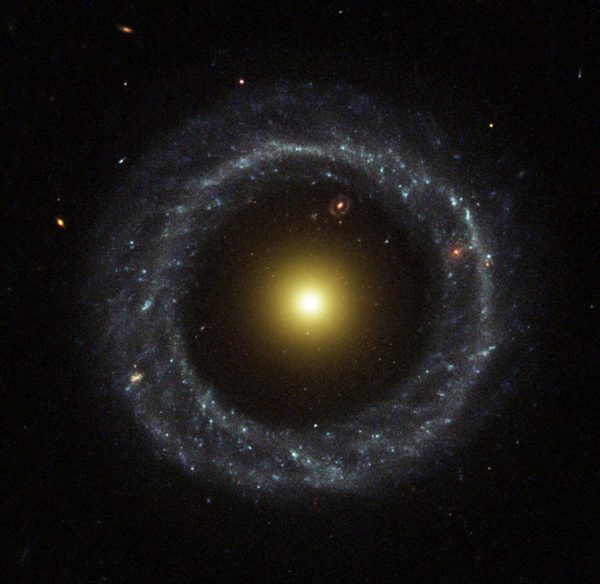
A Wheel within a Wheel
Acknowledgment: Ray A. Lucas (STScI/AURA)
A nearly perfect ring of hot, blue stars pinwheels about the yellow nucleus of an unusual galaxy known as Hoag's Object. This image from NASA's Hubble Space Telescope captures a face-on view of the galaxy's ring of stars, revealing more detail than any existing photo of this object. The image may help astronomers unravel clues on how such strange objects form.
The entire galaxy is about 120,000 light-years wide, which is slightly larger than our Milky Way Galaxy. The blue ring, which is dominated by clusters of young, massive stars, contrasts sharply with the yellow nucleus of mostly older stars. What appears to be a "gap" separating the two stellar populations may actually contain some star clusters that are almost too faint to see. Curiously, an object that bears an uncanny resemblance to Hoag's Object can be seen in the gap at the one o'clock position. The object is probably a background ring galaxy.
Ring-shaped galaxies can form in several different ways. One possible scenario is through a collision with another galaxy. Sometimes the second galaxy speeds through the first, leaving a "splash" of star formation. But in Hoag's Object there is no sign of the second galaxy, which leads to the suspicion that the blue ring of stars may be the shredded remains of a galaxy that passed nearby. Some astronomers estimate that the encounter occurred about 2 to 3 billion years ago.
This unusual galaxy was discovered in 1950 by astronomer Art Hoag. Hoag thought the smoke-ring-like object resembled a planetary nebula, the glowing remains of a Sun-like star. But he quickly discounted that possibility, suggesting that the mysterious object was most likely a galaxy. Observations in the 1970s confirmed this prediction, though many of the details of Hoag's galaxy remain a mystery.
The galaxy is 600 million light-years away in the constellation Serpens. The Wide Field and Planetary Camera 2 took this image on July 9, 2001.

"Backwards" Spiral Galaxy
Acknowledgment: Dr. Ron Buta (U. Alabama), Dr. Gene Byrd (U. Alabama) and Tarsh Freeman (Bevill State Community College)
To the surprise of astronomers, the galaxy, called NGC 4622, appears to be rotating in the opposite direction to what they expected. Pictures by NASA's Hubble Space Telescope helped astronomers determine that the galaxy may be spinning clockwise by showing which side of the galaxy is closer to Earth. A Hubble telescope photo of the oddball galaxy is this month's Hubble Heritage offering. The image shows NGC 4622 and its outer pair of winding arms full of new stars [shown in blue].
Astronomers are puzzled by the clockwise rotation because of the direction the outer spiral arms are pointing. Most spiral galaxies have arms of gas and stars that trail behind as they turn. But this galaxy has two "leading" outer arms that point toward the direction of the galaxy's clockwise rotation. To add to the conundrum, NGC 4622 also has a "trailing" inner arm that is wrapped around the galaxy in the opposite direction it is rotating. Based on galaxy simulations, a team of astronomers had expected that the galaxy was turning counterclockwise.
NGC 4622 is a rare example of a spiral galaxy with arms pointing in opposite directions. What caused this galaxy to behave differently from most galaxies? Astronomers suspect that NGC 4622 interacted with another galaxy. Its two outer arms are lopsided, meaning that something disturbed it. The new Hubble image suggests that NGC 4622 consumed a small companion galaxy. The galaxy's core provides new evidence for a merger between NGC 4622 and a smaller galaxy. This information could be the key to understanding the unusual leading arms.
Galaxies, which consist of stars, gas, and dust, rotate very slowly. Our Sun, one of many stars in our Milky Way Galaxy, completes a circuit around the Milky Way every 250 million years.
NGC 4622 resides 111 million light-years away in the constellation Centaurus. The pictures were taken in May 2001 with Hubble's Wide Field Planetary Camera 2.
The science team, consisting of Ron Buta and Gene Byrd from the University of Alabama, Tuscaloosa, and Tarsh Freeman of Bevill State Community College in Alabama, observed NGC 4622 in ultraviolet, infrared, and blue and green filters. Their composite image and science findings were presented at the meeting of the American Astronomical Society in January of 2002.
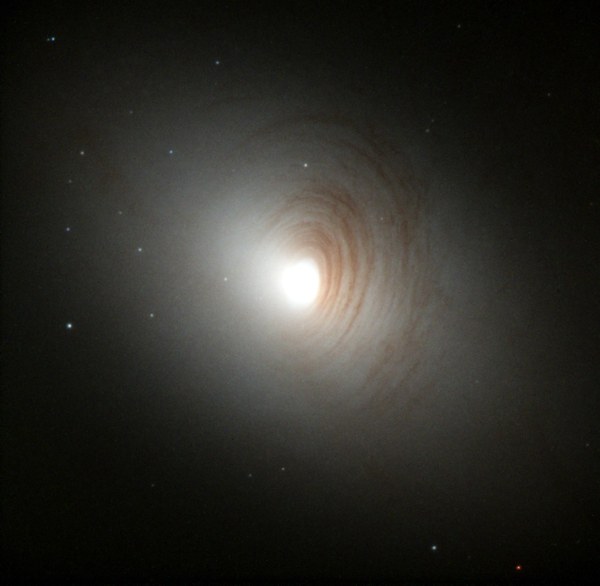
A Galaxy That's All Wound Up
Acknowledgment: M. Carollo (Swiss Federal Institute of Technology, Zurich)
Tightly wound, almost concentric, arms of dark dust encircle the bright nucleus of galaxy NGC 2787 in this NASA Hubble Space Telescope image created by the Hubble Heritage Team.
In astronomer Edwin Hubble's galaxy classification scheme, NGC 2787 is classified as an SB0, a barred lenticular galaxy. These lens-shaped galaxies show little or no evidence of the grand spiral arms that occur in their more photogenic cousins, though NGC 2787 does sport a faint bar, not apparent in this image.
NGC 2787's seemingly bland qualities are, however, just what the doctor ordered for astronomer Marcella Carollo's investigation. Dr. Carollo (Swiss Federal Institute of Technology, Zurich) and team used Hubble to look at the center of these galaxies for clues about the process of galaxy formation including the role of galaxy collisions and central black holes.
Also visible in the Heritage image are about a dozen globular clusters hovering around NGC 2787. What appear to be stars are, in fact, gravitationally bound families of 100,000's of ancient stars orbiting the center of NGC 2787.
NGC 2787 lies roughly 24 million light-years (7.4 megaparsecs) from Earth in the constellation Ursa Major. Data was collected with the Wide Field Planetary Camera 2 in January 1999. This Heritage image was made by combining light from blue, green and infrared filters from the 1999 dataset.
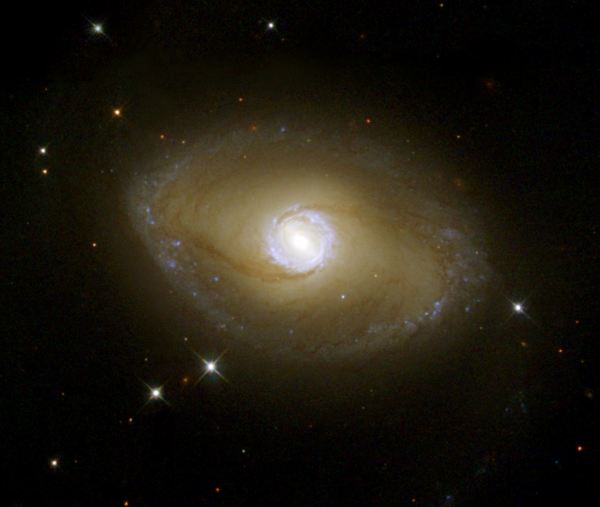
Ultraviolet Galactic Ring
Acknowledgment: R. Windhorst (ASU)
The appearance of a galaxy can depend strongly on the color of the light with which it is viewed. The Hubble Heritage image of NGC 6782 illustrates a pronounced example of this effect. This spiral galaxy, when seen in visible light, exhibits tightly wound spiral arms that give it a pinwheel shape similar to that of many other spirals. However, when the galaxy is viewed in ultraviolet light with NASA's Hubble Space Telescope, its shape is startlingly different.
Ultraviolet light has a shorter wavelength than ordinary visible light, and is emitted from stars that are much hotter than the Sun. At ultraviolet wavelengths, which are rendered as blue in the Hubble image, NGC 6782 shows a spectacular, nearly circular bright ring surrounding its nucleus. The ring marks the presence of many recently formed hot stars.
Two faint, dusty spiral arms emerge from the outer edge of the blue ring and are seen silhouetted against the golden light of older and fainter stars. A scattering of blue stars at the outer edge of NGC 6782 in the shape of two dim spiral arms shows that some star formation is occurring there too. The inner ring surrounds a small central bulge and a bar of stars, dust, and gas. This ring is itself part of a larger dim bar that ends in these two outer spiral arms. Astronomers are trying to understand the relationship between the star formation seen in the ultraviolet light and how the bars may help localize the star formation into a ring.
NGC 6782 is a relatively nearby galaxy, residing about 183 million light-years from Earth. The light from galaxies at much larger distances is stretched to longer, redder wavelengths ["redshifted"], due to the expansion of the universe. This means that if astronomers want to compare visible-light images of very distant galaxies with galaxies in our own neighborhood, they should use ultraviolet images of the nearby ones. Astronomers find that the distant galaxies tend to have different structures than nearby ones, even when they use the correct procedure of comparing visible light in distant galaxies with ultraviolet light from nearby ones. Since the distant galaxies are seen as they were billions of years ago, such observations are evidence that galaxies evolve with time.
The Hubble image of NGC 6782 was taken with the Wide Field Planetary Camera 2 (WFPC2) in June 2000 as part of an ultraviolet survey of 37 nearby galaxies. The observations were carried out by an international "Hubble mid-UV team" led by Dr. Rogier Windhorst of Arizona State University. Additional observations of NGC 6782 were made by the Hubble Heritage Team in June 2001. The color image was produced by combining data from both observing programs that were taken through color filters in the WFPC2 camera that isolated ultraviolet, blue, visible, and infrared light.

Galaxies in Infrared
Astronomers have used the NASA Hubble Space Telescope to produce an infrared "photo essay" of spiral galaxies. By penetrating the dust clouds swirling around the centers of these galaxies, the telescope’s infrared vision is offering fresh views of star birth.
These six images, taken with the Near Infrared Camera and Multi-Object Spectrometer, showcase different views of spiral galaxies, from a face-on image of an entire galaxy to a close-up of a core. The top row shows spirals at diverse angles, from face-on, (left); to slightly tilted, (center); to edge-on, (right). The bottom row shows close-ups of the hubs of three galaxies.
In these images, red corresponds to glowing hydrogen, the raw material for star birth. The red knots outlining the curving spiral arms in NGC 5653 and NGC 3593, for example, pinpoint rich star-forming regions where the surrounding hydrogen gas is heated by intense ultraviolet radiation from young, massive stars. In visible light, many of these regions can be hidden from view by the clouds of gas and dust in which they were born.
The glowing hydrogen found inside the cores of these galaxies, as in NGC 6946, may be due to star birth; radiation from active galactic nuclei (AGN), which are powered by massive black holes; or a combination of both. White is light from middle-age stars. Clusters of stars appear as white dots, as in NGC 2903. The galaxy cores are mostly white because of their dense concentration of stars. The dark material seen in these images is dust.
These galaxies are part of a Hubble census of about 100 spiral galaxies. Astronomers at the Space Telescope Science Institute used Director’s Discretionary Time to survey these galaxies in the spring and fall of 1998.
Filters: Three filters were used: red, blue, and green. Red represents emission at the Paschen Alpha line (light from glowing hydrogen) at a wavelength of 1.87 microns. Blue shows the galaxies in near-infrared light, measured between 1.4 and 1.8 microns (H-band emission). Green is a mixture of the two.
Distance of galaxies from Earth:
NGC 5653 - 161 million light-years
NGC 3593 - 28 million light-years;
NGC 891 - 24 million light-years
NGC 6946 - 20 million light-years.
NGC 4826 - 19 million light-years;
NGC 2903 - 25 million light-years
 CosmicLight.com Home
CosmicLight.com Home